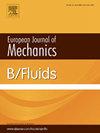Numerical investigation of the role of human motion in the spread of virus-laden droplets from coughing using CFD dynamic mesh technique
IF 2.5
3区 工程技术
Q2 MECHANICS
引用次数: 0
Abstract
The transmission of viruses through the air plays a crucial role in the spread of viral diseases in enclosed environments. The mobility of individuals is a potential factor that contributes to the increment of the propagation of respiratory infections through the air. This research comprehensively focuses on transient modelling of the spread of solid-containing droplets during a cough from a moving person inside a ventilated room through CFD approach. This study investigates a range of moving speeds, from 0 to 1.5 m/s, to illustrate differences in patterns and concentration of droplets during both mobile and stationary conditions of an individual considering the interactions among gas, liquid and solid phases. Interactions between phases are considered through a coupled Eulerian–Lagrangian approach, and discrete phase model (DPM), turbulence model, species transport model, evaporation model and dynamic mesh technique are integrated. Moreover, the influences of effective forces such as buoyancy, Brownian motion, drag, lift, and gravitational forces are included. Regarding the results, motion of individuals significantly affects the airflow pattern and dispersion of droplets, particularly for walking speeds of more than 1 m/s. The results also elaborately indicate that person’s movement (from 0 to 1.5 m/s) considerably enhances the turbulent intensity (about 40 %), average air velocity and oscillations in pressure distribution, especially, pressure gradient before and after the moving person (about 1.5 Pa). Additionally, when the person walks at speeds exceeding 1 m/s, most of the particles cannot attach to the person’s body due to insufficient time for settling, resulting in an increment in the total number of particles that remain suspended in the air.
利用CFD动态网格技术对人体运动在咳嗽飞沫传播中的作用进行数值研究
病毒通过空气的传播在封闭环境中病毒性疾病的传播中起着至关重要的作用。个体的流动性是增加呼吸道感染通过空气传播的潜在因素。本研究通过CFD方法全面研究了通风室内移动人员咳嗽过程中含固体飞沫传播的瞬态模型。本研究调查了从0到1.5 m/s的移动速度范围,以说明考虑到气、液和固相之间的相互作用,个体在移动和静止条件下液滴的模式和浓度的差异。通过欧拉-拉格朗日耦合方法考虑相间相互作用,将离散相模型(DPM)、湍流模型、物种输运模型、蒸发模型和动态网格技术相结合。此外,还包括浮力、布朗运动、阻力、升力和重力等有效力的影响。从结果来看,个体的运动显著影响气流模式和液滴的分散,特别是当行走速度大于1 m/s时。结果还详细说明,人的运动(0 ~ 1.5 m/s)显著增强了湍流强度(约40 %)、平均风速和压力分布的振荡,特别是人运动前后的压力梯度(约1.5 Pa)。此外,当人以超过1 m/s的速度行走时,由于沉降时间不足,大多数颗粒不能附着在人的身体上,导致悬浮在空气中的颗粒总数增加。
本文章由计算机程序翻译,如有差异,请以英文原文为准。
求助全文
约1分钟内获得全文
求助全文
来源期刊
CiteScore
5.90
自引率
3.80%
发文量
127
审稿时长
58 days
期刊介绍:
The European Journal of Mechanics - B/Fluids publishes papers in all fields of fluid mechanics. Although investigations in well-established areas are within the scope of the journal, recent developments and innovative ideas are particularly welcome. Theoretical, computational and experimental papers are equally welcome. Mathematical methods, be they deterministic or stochastic, analytical or numerical, will be accepted provided they serve to clarify some identifiable problems in fluid mechanics, and provided the significance of results is explained. Similarly, experimental papers must add physical insight in to the understanding of fluid mechanics.

 求助内容:
求助内容: 应助结果提醒方式:
应助结果提醒方式:


